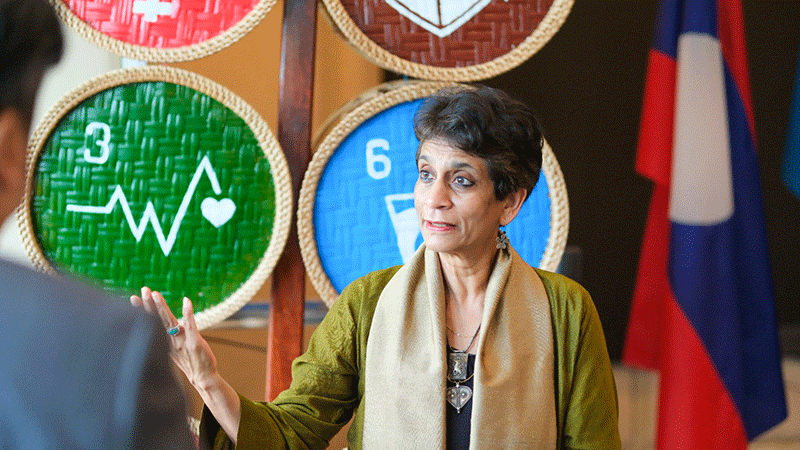 |
| United Nations (UN) Assistant Secretary-General Kanni Wignaraja talks to local media. --Photo UNDP |
Laos is ‘on track to graduate from least developed country status’: UN Assistant Secretary-General
The government’s goal to raise the nation out of least developed country (LDC) status by 2026 ‘is achievable’ despite continuing economic and financial challenges, and global turbulence, the visiting United Nations (UN) Assistant Secretary-General has said.
Ms Kanni Wignaraja, who is also UNDP Regional Director for Asia and the Pacific, is making an official visit to Laos to advance the partnership between Laos and UNDP - the country’s main development partner.
“I really think Laos is on track [for LDC graduation]. We are not less developed. We are on track to be a middle-income country,” she told reporters at the UNDP offices in Vientiane.
The UNDP regional chief expressed optimism about the prospects for graduation despite concerns raised by many that Laos, like many LDC countries, could suffer during the transition or post-graduation period, fearing that newly graduated nations could be disadvantaged by aid cuts and loss of preferential trade privileges offered by major economies to LDC countries.
“I think LDC graduation is a moment to celebrate. I don’t see it as a challenge. I see it as an opportunity,” she said.
Ms Wignaraja suggested that a newly graduated country needs to move beyond what it is used to in the past, including some of the former preferential trade agreements, and instead explore opportunities to negotiate new trade deals with competitive proposals that position itself as an attractive destination for foreign direct investment and secure new financing sources.
Laos, she added, could pursue becoming a renewable-energy-driven country, leveraging its hydropower potential for both domestic use and export – an important approach to promote the country as a clean production base aligning with the government’s green growth policy and global trends.
The UNDP chief advised Laos to forge stronger regional links, explore new markets, and then offer new products and services accordingly.
“I think these are areas, and there will be many more, where Laos can really be a leader in its post LDC phase,” she said, adding that this potential creates a competitive edge when negotiating new trade deals.
Ms Wignaraja also underscored the need to invest more in young people, to ensure the workforce is highly capable and competitive, by reinvesting in education and health.
“The averages of the national budget in these two sectors are far, far too low,” Ms Wignaraja said, adding that quality education is needed to encourage students to stay in schools until completion of the curriculum.
Ms Wignaraja said the UNDP stands ready to support and work with Laos as it prepares to graduate from LDC status and fulfil the Sustainable Development Goals (SDGs).
Her visit comes at a prime time, when the government is formulating its 10th five-year National Socio-Economic Development Plan for 2026-2030. This is a critical framework that will witness Laos’ transition from LDC and determine whether the country can achieve all the SDGs by 2030 as planned.
The five-year development plan is being finalised amid internal and external challenges caused by financial difficulties, a decline in global aid flow, the global trade outlook, and tariff changes.
Preliminary assessments supported by UNDP suggest that Laos will require tens of billions of US dollars to finance its development priorities for the 2026-2030 period, with acute gaps in financing climate and human development needs.
To address these gaps, the government, in partnership with UNDP, on Monday launched the Climate and Sustainable Finance Hub to strengthen future development financing, in the presence of Ms Wignaraja.
“I’m here to see what we can do to support the Lao PDR government and all the stakeholders to look at that next stage of development for Laos,” she said.
By Souksakhone Vaenkeo
(Latest Update September 11, 2025)
|


